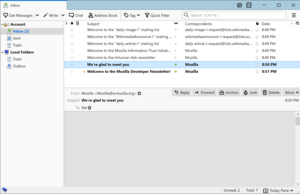Mozilla Thunderbird
Mozilla Thunderbird is a free and open-source[9] cross-platform email client, news client, RSS, and chat client developed by the Mozilla Foundation. The project strategy was modeled after that of the Mozilla Firefox web browser.
 | |
 Mozilla Thunderbird 60.0 | |
| Developer(s) |
|
|---|---|
| Initial release | July 28, 2003 |
| Stable release | 78.1.1[1] (August 6, 2020) [±] |
| Preview release | 80.0 Beta 3[2] (August 11, 2020) [±] |
| Repository | |
| Written in | C, C++, JavaScript,[3] CSS,[4][5] Rust, XUL, XBL |
| Operating system | Windows 7 or later; OS X 10.9 or later; FreeBSD; Linux[6] |
| Size | 50 MB |
| Available in | 56 languages |
List of languages Albanian, Arabic, Armenian, Asturian, Basque, Belarusian, Breton, Bulgarian, Catalan, Chinese (Simplified), Chinese (Traditional), Croatian, Czech, Danish, Dutch, English (British), English (US), Estonian, Finnish, French, Frisian, Gaelic (Scotland), Galician, German, Greek, Hebrew, Hungarian, Icelandic, Indonesian, Irish, Italian, Japanese, Kabyle, Korean, Lithuanian, Lower Sorbian, Norwegian (Bokmål), Norwegian (Nynorsk), Polish, Portuguese (Brazilian), Portuguese (Portugal), Romanian, Romansh, Russian, Serbian, Sinhala, Slovak, Slovenian, Spanish (Argentina), Spanish (Spain), Swedish, Turkish, Ukrainian, Upper Sorbian, Vietnamese, Welsh.[7] | |
| Type | Email client, news client, feed reader |
| License | MPL 2.0[8] |
| Website | www |
On December 7, 2004, version 1.0 was released, and received more than 500,000 downloads in its first three days of release, and 1,000,000 in ten days.[10][11]
On July 6, 2012, Mozilla announced the company was dropping the priority of Thunderbird development because the continuous effort to extend Thunderbird's feature set was mostly fruitless. The new development model shifted to Mozilla offering only "Extended Support Releases", which deliver security and maintenance updates, while allowing the community to take over the development of new features.[12][13]
On December 1, 2015, Mozilla Executive Chair Mitchell Baker announced in a company-wide memo that Thunderbird development needs to be uncoupled from Firefox. She referred to Thunderbird developers spending large efforts responding to changes to Mozilla technologies, while Firefox was paying a tax to support Thunderbird development. She also said that she does not believe Thunderbird has the potential for "industry-wide impact" that Firefox does.[14][15] At the same time, it was announced that Mozilla Foundation would provide at least a temporary legal and financial home for the Thunderbird project.[16]
Since the memo in 2015, Mozilla has brought Thunderbird back in-house in an announcement on May 9, 2017, and continues to support its development.[17][18] The Thunderbird development team has also expanded by adding several new members and has undergone an overhaul on security and user interface.[19]
On January 28, 2020, the Mozilla Foundation announced that the project would henceforth be operating from a new wholly owned subsidiary, MZLA Technologies Corporation, in order to explore offering products and services that were not previously possible and to collect revenue through partnerships and non-charitable donations.[20]
Features
Thunderbird is an email, newsgroup, news feed, and chat (XMPP, IRC, Twitter) client. The vanilla version was not originally a personal information manager (PIM), although the Mozilla Lightning extension, which is now installed by default, adds PIM functionality. Additional features, if needed, are often available via other extensions.
Message management
Thunderbird can manage multiple email, newsgroup, and news feed accounts and supports multiple identities within accounts. Features such as quick search, saved search folders ("virtual folders"), advanced message filtering, message grouping, and labels help manage and find messages. On Linux-based systems, system mail (movemail) accounts are supported. Thunderbird provides basic support for system-specific new email notifications and can be extended with advanced notification support using an add-on.[21]
Junk filtering
Thunderbird incorporates a Bayesian spam filter, a whitelist based on the included address book, and can also understand classifications by server-based filters such as SpamAssassin.[22]
Extensions and themes
Extensions allow the addition of features through the installation of XPInstall modules (known as "XPI" or "zippy" installation) via the add-ons website that also features an update functionality to update the extensions.
Thunderbird supports a variety of themes for changing its overall look and feel. These packages of CSS and image files can be downloaded via the add-ons website at Mozilla Add-ons.[23]
Standards support
Thunderbird follows industry standards for email:
- POP. Basic email retrieval protocol.
- IMAP. Thunderbird has implemented many of the capabilities in IMAP, in addition to adding their own extensions and the de facto standards by Google and Apple.[24]
- LDAP address completion.
- S/MIME provides email encryption and signing using X.509 keys provided by a centralised certificate authority.
- OpenPGP Supported through extensions such as Enigmail.
For web feeds (e.g. news aggregators), it supports Atom and RSS.
For chat, it supports the IRC protocol.
For newsfeeds, it uses NNTP and supports NNTPS.
File formats supported
Thunderbird provides mailbox format support using plugins, but this feature is not yet enabled due to related work in progress.[25] The mailbox formats supported as of July 2014 are:
- mbox – Unix mailbox format (one file holding many emails)
- maildir – known as maildir-lite (one file per email). As of August 2019 "there are still many bugs", so this is disabled by default.[26]
Thunderbird also uses Mork and (since version 3) MozStorage (which is based on SQLite) for its internal database. Mork was due to be replaced with MozStorage in Thunderbird 3.0,[27] but the 8.0 release still uses the Mork file format. The current version of SeaMonkey, version 2.14.1, also still uses Mork for its indexes for both POP and IMAP mail folders (at least).
Big file linking
Since version 38, Thunderbird has integrated support for automatic linking of large files instead of attaching them directly to the mail message.
HTML code insertion
The Insert menu provides the ability to include HTML code. Thus, one can insert subscripts with <sub> and </sub>, the degree symbol ° with °, etc., into a message being composed.
Limitations and known issues
As with any software, there may be limitations to the number and sizes of files and objects represented. For example, POP3 folders are subject to filesystem design limitations, such as maximum file sizes on filesystems that do not have large-file support, as well as possible limitations of long filenames, and other issues.[28]
Cross-platform support
Thunderbird runs on a variety of platforms. Releases available on the primary distribution site support the following operating systems:[29][30]
Unofficial ports are available for:
Other old ports may be available as for OS/2 and eComStation.[33][34]
The source code is freely available and can be compiled to be run on a variety of other architectures and operating systems.
Internationalization and localization
With contributors all over the world, the client is translated into more than 50 languages, although email addresses are currently limited to ASCII local parts.[35] Thunderbird does not yet support SMTPUTF8 (RFC 6531) or Email Address Internationalization.
Security
Thunderbird provides security features such as TLS/SSL connections to IMAP and SMTP servers. It also offers native support for S/MIME secure email (digital signing and message encryption using certificates). Any of these security features can take advantage of smartcards with the installation of additional extensions.
Other security features may be added through extensions. For instance, Enigmail offers PGP signing, encryption, and decryption.
Optional security protections also include disabling loading of remote images within messages, enabling only specific media types (sanitizer), and disabling JavaScript.
The French military uses Thunderbird and contributes to its security features, which are claimed to match the requirements for NATO's closed messaging system.[36]
Thunderbird is also installed by default on Ubuntu desktop systems as well as many other Linux distributions.
History


Originally launched as Minotaur shortly after Phoenix (the original name for Mozilla Firefox), the project failed to gain momentum. With the success of the latter, however, demand increased for a mail client to go with it, and the work on Minotaur was revived under the new name of Thunderbird, and migrated to the new toolkit developed by the Firefox team.
Significant work on Thunderbird restarted with the announcement that from version 1.5 onward, the main Mozilla suite would be designed around separate applications using this new toolkit. This contrasts with the previous all-in-one approach, allowing users to mix and match the Mozilla applications with alternatives. The original Mozilla Suite continues to be developed as SeaMonkey.
On December 23, 2004, Project Lightning was announced which tightly integrated calendar functionality (scheduling, tasks, etc.) into Thunderbird. Lightning supports the full range of calendar mechanisms and protocols supported by the Mozilla Calendar infrastructure, just as with modern (post-0.2) Sunbird.
On October 11, 2006, Qualcomm and the Mozilla Foundation announced that "future versions of Eudora will be based upon the same technology platform as the open source Mozilla Thunderbird email program."[37] The project is code-named Penelope.
In late 2006, Debian rebranded Thunderbird as Icedove due to trademark and copyright reasons. This was the second product to be rebranded.[9][38]
On July 26, 2007, the Mozilla Foundation announced that Thunderbird would be developed by an independent organization, because the Mozilla Corporation (a subsidiary of the foundation) was focusing on Mozilla Firefox development.[39]
On September 17, 2007, the Mozilla Foundation announced the funding of a new internet communications initiative with Dr. David Ascher of ActiveState. The purpose of this initiative was "to develop Internet communications software based on the Thunderbird product, code, and brand".[40]
On February 19, 2008, Mozilla Messaging started operations as a subsidiary of the Mozilla Foundation responsible for the development of email and similar communications. Its initial focus was on the then-upcoming version of Thunderbird 3. Alpha Preview releases of Thunderbird 3 were codenamed "Shredder".
On April 4, 2011, Mozilla Messaging was merged into the Mozilla Labs group of the Mozilla Foundation.[41]
On July 6, 2012, a confidential memo from Jb Piacentino, the Thunderbird Managing Director at Mozilla, was leaked and published to TechCrunch.[42] The memo indicated that Mozilla would be moving some of the team off the project and further development of new features would be left up to the community. The memo was slated for release on July 9, 2012. A subsequent article by the Executive Chair of Mozilla, Mitchell Baker, stated Mozilla's decision to make a transition of Thunderbird to a new release and governance model.[12][13]
On November 25, 2014, Kent James of the volunteer-led Thunderbird Council announced on the Thunderbird blog that active contributors to Thunderbird gathered at the Mozilla office in Toronto and discussed the future of the application. They have decided that more staff are required working full-time on Thunderbird so that the Thunderbird Team can release a stable and reliable product and make progress on features that have been frequently requested by the community.[43]
On December 1, 2015, Mitchell Baker suggested in a company-wide memo that Thunderbird should be uncoupled from Firefox's infrastructure.[14] She referred to Thunderbird as being a tax on Firefox and said that she does not believe Thunderbird has the potential for "industry-wide impact" that Firefox does.[44] Mozilla remains interested in having a role in Thunderbird, but sought more assistance to help with development.[45]
On May 9, 2017, Philipp Kewisch announced that the Mozilla Foundation would continue to serve as the legal and fiscal home for the Thunderbird project, but that Thunderbird would migrate off Mozilla Corporation infrastructure, separating the operational aspects of the project.[46]
The interim/beta versions Thunderbird 57 and 58, released in late 2017, began to make changes influenced by Firefox Quantum, including a new "Photon" user interface.[47][48]
Despite the removal in Firefox Quantum of support for XUL-based legacy add-ons in favor of WebExtensions, the stable/ESR release of Thunderbird 60 in mid-2018 continued to support them, although most will require updates, and it does not support WebExtensions except for Themes.[49][50]
In 2018, according to Mozilla, work was underway for planned support in Thunderbird 63 of WebExtensions and to continue to "somewhat" support legacy addons.[51]
With the release of Thunderbird 68 in August 2019 it now only supports WebExtension addons. [52] Legacy Addons can still be used if a special "legacy mode" is enabled, but even for this, the legacy Addon has to be converted. [53]
Releases
Thunderbird development releases occur in three stages, called Beta, Earlybird, and Daily, which correspond to Firefox's Beta, Aurora, and Nightly stages. The release dates and Gecko versions are exactly the same as Firefox; for example, Firefox 7 and Thunderbird 7 were both released on September 27, 2011, and were both based on Gecko 7.0.

References
- "Thunderbird — Release Notes (78.1.1)". Mozilla Foundation. August 6, 2020. Retrieved August 6, 2020.
- "Thunderbird — Beta Notes (80.0beta) — Thunderbird". August 11, 2020. Retrieved August 12, 2020.
- "Firefox's addons are written in JavaScript". Rietta. Archived from the original on August 4, 2009. Retrieved December 19, 2009.
- "Firefox uses an "html.css" stylesheet for default rendering styles". David Walsh. Retrieved December 19, 2009.
- "The Firefox addon, Stylish takes advantage of Firefox's CSS rendering to change the appearance of Firefox". userstyles.org. Archived from the original on May 23, 2009. Retrieved December 19, 2009.
- "Thunderbird 78.0 System Requirements". mozilla.org. Mozilla Messaging. Retrieved July 17, 2020.
- "Download a Thunderbird that SPEAKS YOUR LANGUAGE". mozilla.com. Retrieved March 1, 2015.
- Mozilla Licensing Policies, mozilla.org, retrieved January 5, 2012
- "Debian and Mozilla – a study in trademarks". LWN.net. Retrieved September 18, 2010.
- "thunderbird breaks half a million downloads in three days". Asa Dotzler's Blog. December 10, 2004. Archived from the original on February 11, 2012. Retrieved February 9, 2013.
- "thunderbird 1.0 reaches 1,000,000 downloads in just 10 days!". Asa Dotzler's Blog. December 18, 2004. Archived from the original on July 8, 2013. Retrieved February 9, 2013.
- "Thunderbird: Stability and Community Innovation". Mitchell's Blog. July 6, 2012. Retrieved August 18, 2012.
- "Thunderbird/New Release and Governance Model". MozillaWiki. Retrieved February 14, 2015.
- Baker, Mitchell. "Mozilla Governance: Thunderbird, the future, mozilla-central and comm-central". Google Groups, Mozilla Governance. Retrieved January 2, 2016.
- Lunden, Ingrid. "Mozilla Wants To Split Off Its Thunderbird Email/Chat Client, Says Mitchell Baker Memo". TechCrunch. Retrieved December 4, 2015.
- Kent, James. "Thunderbird Active Daily Inquiries Surpass 10 Million!". The Mozilla Thunderbird Blog. Retrieved January 2, 2016.
- Kewisch, Philipp. "Thunderbird's Future Home". The Mozilla Thunderbird Blog. Mozilla. Retrieved May 29, 2019.
- Lardinois, Frederic. "Mozilla promises a faster, prettier Thunderbird with better Gmail support". TechCrunch. Retrieved May 29, 2019.
- Sipes, Ryan. "Thunderbird in 2019". The Mozilla Thunderbird Blog. Mozilla. Retrieved May 29, 2019.
- "Thunderbird's New Home". The Mozilla Thunderbird Blog. Retrieved January 28, 2020.
- "GNotifier". addons.mozilla.org. Retrieved July 21, 2017.
- "Mozillazine Forums". Forums.mozillazine.org. Retrieved June 18, 2009.
- "Themes :: Add-ons for Thunderbird". mozilla.org.
- "MailNews:Supported IMAP extensions". mozilla.org.
- "402392 – Support other message storage formats. (prelude to pluggable mail stores)". mozilla.org. Retrieved March 1, 2015.
- "Maildir in Thunderbird". Thunderbird Help. Mozilla. Retrieved August 30, 2019.
- "Thunderbird 3 Planning". Wiki.mozilla.org. August 10, 2009. Retrieved August 19, 2009.
- "Limits – Thunderbird". mozillazine.org. Retrieved March 8, 2015.
- "Mozilla Thunderbird 24.0 System Requirements". Mozilla.org. Retrieved November 13, 2013.
- "Mozilla Thunderbird". Mozillamessaging.com. Archived from the original on May 14, 2012. Retrieved November 13, 2013.
- "mail/thunderbird". FreshPorts. Retrieved August 18, 2012.
- "thunderbird-31.4.0 – Mozilla e-mail, rss and usenet client". OpenBSD ports. Retrieved March 1, 2015.
- "Warpzilla – Mozilla for OS/2". Os2news.warpstock.org. Archived from the original on September 19, 2018. Retrieved August 6, 2018.
Firefox 52esr is the last version that will be ported to OS/2.
- "Ports/os2 – MozillaWiki". Mozilla.org. Retrieved November 13, 2013.
- "Mozilla Thunderbird – Reclaim Your Inbox". Mozilla.com. Retrieved November 13, 2013.
- Marcel Michelson (December 10, 2009). "French Military Donated Code to Mozilla Thunderbird". Reuters. Retrieved April 24, 2011.
- "QUALCOMM Launches Project in Collaboration with Mozilla Foundation to Develop Open Source Version of Eudora Email Program" (Press release). Eudora.com. October 11, 2006. Archived from the original on October 1, 2013. Retrieved November 13, 2013.
- "Uses Mozilla Firefox trademark without permission – Debian Bug Tracker". Debian. Retrieved September 18, 2010.
- Claburn, Thomas (July 27, 2007). "Mozilla Gives Thunderbird E-Mail The Boot". Internet section. Retrieved July 31, 2007.
- "Mozilla Launches Internet Mail and Communications Initiative" (Press release). Mozilla.com. September 17, 2007. Retrieved June 18, 2009.
- Paul, Ryan (April 5, 2011). "Thunderbird returns to nest as Mozilla Messaging rejoins Mozilla". Ars Technica. Retrieved April 5, 2011.
- Sarah Perez (July 6, 2012). "So, That's It For Thunderbird". TechCrunch. Retrieved August 18, 2012.
- "Thunderbird Reorganizes at 2014 Toronto Summit". The Mozilla Thunderbird Blog. November 25, 2014. Retrieved February 1, 2015.
- "Mozilla Wants To Split Off Its Thunderbird Email/Chat Client, Says Mitchell Baker Memo". TechCrunch. December 1, 2015. Retrieved December 2, 2015.
- "Thunderbird Update | Mitchell's Blog". blog.lizardwrangler.com. Retrieved October 13, 2016.
- Kewisch, Philipp. "Thunderbird's Future Home". The Mozilla Thunderbird Blog. Mozilla. Retrieved May 11, 2017.
- Ghoshal, Abhimanyu (December 20, 2017). "Mozilla's Thunderbird email client isn't dead yet". The Next Web. Retrieved December 26, 2017.
- "New Thunderbird Releases and New Thunderbird Staff". The Mozilla Thunderbird Blog. Retrieved December 26, 2017.
- "Thunderbird/Add-ons Guide 57 - MozillaWiki". wiki.mozilla.org. Retrieved September 24, 2018.
- "Thunderbird — Release Notes (60.0)". Thunderbird. Retrieved September 24, 2018.
- "Thunderbird/Add-ons Guide 63 - MozillaWiki". wiki.mozilla.org. Retrieved September 24, 2018.
- "Thunderbird — Release Notes (68.0)". Thunderbird. Retrieved December 8, 2019.
- "Updating Legacy Extensions for Thunderbird 68". developer.thunderbird.net. Retrieved December 8, 2019.